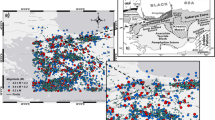Abstract
Reconnaissance reports and pertinent research on seismic hazards show that liquefaction is one of the key sources of damage to geotechnical and structural engineering systems. Therefore, identifying site liquefaction conditions plays an important role in seismic hazard mitigation. One of the widely used approaches for detecting liquefaction is based on the time-frequency analysis of ground motion recordings, in which short-time Fourier transform is typically used. It is known that recordings at a site with liquefaction are the result of nonlinear responses of seismic waves propagating in the liquefied layers underneath the site. Moreover, Fourier transform is not effective in characterizing such dynamic features as time-dependent frequency of the recordings rooted in nonlinear responses. Therefore, the aforementioned approach may not be intrinsically effective in detecting liquefaction. An alternative to the Fourier-based approach is presented in this study, which proposes time-frequency analysis of earthquake ground motion recordings with the aid of the Hilbert-Huang transform (HHT), and offers justification for the HHT in addressing the liquefaction features shown in the recordings. The paper then defines the predominant instantaneous frequency (PIF) and introduces the PIF-related motion features to identify liquefaction conditions at a given site. Analysis of 29 recorded data sets at different site conditions shows that the proposed approach is effective in detecting site liquefaction in comparison with other methods.
Similar content being viewed by others
References
Bennett MJ, McLaughlin PV, Sarmiento JS and Youd TL (1984), “Geotechnical Investigation of Liquefaction Site, Imperial Valley, California,” Open-file Rep. 84-252, U.S. Geological Survey, Washington, D.C.
Chang CY, Mok CM, Power MS and Tang YK (1991), “Analysis of Ground Response Data at Lotung Large-scale Soil-structure Interaction Experiment Site,” Rep. No. NP-7306-SL, Electric Power Research Institute, Palo Alto, Calif.
Hu YX, Liu SC and Dong WM (1996), Earthquake Engineering, London, Champman & Hall.
Huang NE, Zheng S, Long SR, Wu MC, Shih HH, Zheng Q, Yen NC, Tung CC and Liu MH (1998), “The Empirical Mode Decomposition and Hilbert Spectrum for Nonlinear and Nonstationary Time Series Analysis,” Proc. Roy. Soc Lond., A 454, 903–995.
Huang NE, Wu ML, Long SR, Shen SP, Wu W, Gloersen P and Fan KL (2003), “A Confidence Limit for the Empirical Mode Decomposition and Hilbert Spectral Analysis,” Proc. Roy. Soc Lond., A 459, 2317–2345.
Kostadinov MV and Yamazaki F (2001), “Detection of Soil Liquefaction from Strong Motion Records,” Earthquake Engineering and Structural Dynamics, 30: 173–193.
Kramer SL (1996), Geotechnical Earthquake Engineering, Prentice-Hall, Inc. Upper Saddle River, NJ, pp.653.
Priestley MB (1981), Spectral Analysis and Time Series, Vol. 2, Multivariate Series, Prediction and Control, Academic Press, London, 1981.
Suzuki T, Shimizu Y and Nakayama W (1998), “Characteristics of Strong Motion Records at the Liquefied Sites and Judgment for Liquefaction,” 11 th European Conference on Earthquake Engineering, Paris, France, 6–11 September, CD-ROM. Balkema: Rotterdam.
Uzarski J and Arnold C (2001), “Chi-Chi, Taiwan, Earthquake of September 21, 1999 Reconnaissance Report,” Earthquake Spectra, Supplement A, 17: 1–183.
Worden K and Tomlinson GR (2001), Nonlinearity in Structural Dynamics- Detection, Identification and Modeling, Institute of Physics Publishing, Bristol and Philadelphia.
Youd TL (1999), “Physics and Mechanics of Liquefaction from Field Records and Experience,” Physics and Mechanics of Soil Liquefaction, Eds. Lade and Yamamuro, Balkema, Rotterdam, pp. 325–334.
Youd TL, Bardet JP and Bray JD (2000), “Kocaeli, Turkey, Earthquake of August 17, 1999 Reconnaissance Report,” Earthquake Spectra, Supplement A, 16: 1–456.
Youd TL, Idriss IM, Andrus RD, Arango I, Castro G, Christian JT, Dobry R, Liam Finn WD, Harder LF, Hynes ME, Ishihara K, Koester JP, Liao SSC, Marcuson WF III, Martin, G.R, Mitchell JK, Moriwaki Y, Power MS, Robertson PK, Seed RB and Stokoe KH II (2001), “Liquefaction Resistance of Soils: Summary Report from the 1996 NCEER and 1998 NCEER/NSF Workshops on Evaluation of Liquefaction Resistance of Soil,” ASCE Journal of Geotechnical and Geoenvironmental Engineering, 127: 817–833.
Zhang R, Ma S and Hartzell S (2003a), “Signatures of Seismic Source in EMD-based Characterization of the 1994 Northridge, California, Earthquake Recordings,” Bulletin of the Seismological Society of America, 93: 501–518.
Zhang R, Ma S, Safak E and Hartzell S (2003b), “Hilbert-Huang Transform Analysis of Dynamic and Earthquake Motion Recordings,” Journal of Engineering Mechanics, 129: 861–875.
Zhang R, VanDemark L, Liang J and Hu YX (2004), “On Estimating Site Damping with Soil Nonlinearity from Earthquake Recordings,” International Journal of Non-Linear Mechanics, 39: 1501–1517.
Zhang R, Hartzell S, Liang J and Hu YX (2005), “On Alternative Approach to Characterize Nonlinear Site Effects,” Earthquake Spectra, 21(1): 243–274.
Author information
Authors and Affiliations
Corresponding author
Additional information
Supported by: National Natural Science Foundation of China Under Grant 50278090; the National Science Foundation of the USA with Grant Nos. 0085272 and 0414363; US-PRC Researcher Exchange Program administered by the MCEER
Rights and permissions
About this article
Cite this article
Hu, Y., Zhang, Y., Liang, J. et al. Recording-based identification of site liquefaction. Earthq. Engin. Engin. Vib. 4, 181–189 (2005). https://doi.org/10.1007/s11803-005-0001-3
Received:
Accepted:
Issue Date:
DOI: https://doi.org/10.1007/s11803-005-0001-3




